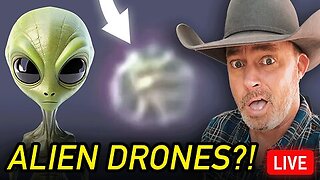Premium Only Content

Episode 1354: Does Montanism still exist?
Montanism known by its adherents as the New Prophecy, was an early Christian movement of the late 2nd century, later referred to by the name of its founder, Montanus. Montanism held views about the basic tenets of Christian theology similar to those of the wider Christian Church, but it was labelled a heresy for its belief in new prophetic revelations. The prophetic movement called for a reliance on the spontaneity of the Holy Spirit and a more conservative personal ethic. Parallels have been drawn between Montanism and modern-day movements such as Pentecostalism (including Oneness Pentecostals) and the Charismatic movement.
Montanism originated in Phrygia, a province of Anatolia, and flourished throughout the region, leading to the movement being referred to elsewhere as Cataphrygian (meaning it was "from Phrygia") or simply as Phrygian. They were sometimes also called Pepuzians after Pepuza, their new Jerusalem. Sometimes the Pepuzians were distinguished from other Montanists for despising those not living in the new Jerusalem. The Montanist movement spread rapidly to other regions in the Roman Empire before Christianity was generally tolerated or legal. It persisted in some isolated places into the 6th century.
The Montanists did not want to separate themselves from the wider Christian church, and Tertullian even recorded an event where a bishop almost declared Montanism as orthodox, however changing his mind later.
History
Scholars debate as to when Montanus first began his prophetic activity, having chosen dates varying from c. AD 135 to as late as AD 177. Montanus was a recent convert when he first began prophesying, supposedly during the proconsulate of Gratus in a village in Mysia named Ardabau; no proconsul and village so named have been identified, however. Some accounts claim that before his conversion to Christianity, Montanus was a priest of Apollo or Cybele. He believed he was a prophet of God and that the Paraclete spoke through him.
Montanus proclaimed the towns of Pepuza and Tymion in west-central Phrygia as the site of the New Jerusalem, making the larger—Pepuza—his headquarters. Phrygia as a source for this new movement was not arbitrary. Hellenization was slow to take root in Phrygia, unlike many of the surrounding eastern regions of the Roman Empire. This sense of difference, while simultaneously having easy access to the rest of the Mediterranean Christian world, encouraged the foundation of this separate sect of Christianity.
Montanus had two female colleagues, Prisca (sometimes called Priscilla, the diminutive form of her name) and Maximilla, who likewise claimed the inspiration of the Holy Spirit. Their popularity even exceeded Montanus' own. "The Three" spoke in ecstatic visions and urged their followers to fast and to pray, so that they might share these revelations. Their followers claimed they received the prophetic gift from the prophets Quadratus and Ammia of Philadelphia, figures believed to have been part of a line of prophetic succession stretching all the way back to Agabus (1st century AD) and to the daughters of Philip the Evangelist. In time, the New Prophecy spread from Montanus's native Phrygia across the Christian world, to Africa and to Gaul.
The response to the New Prophecy split the Christian communities, and the proto-orthodox clergy mostly fought to suppress it. Opponents believed that evil spirits possessed the Phrygian prophets, and both Maximilla and Priscilla were the targets of failed exorcisms.[19] The churches of Asia Minor pronounced the prophecies profane, and excommunicated New Prophecy adherents. Around 177, Apollinarius, Bishop of Hierapolis, presided over a synod which condemned the New Prophecy. The leaders of the churches of Lyons and Vienne in Gaul responded to the New Prophecy in 177. Their decision was communicated to the churches in Asia and Pope Eleuterus, but it is not known what this consisted of, only that it was "prudent and most orthodox". It is likely they called for moderation in dealing with the movement.
There was real doubt at Rome, and its bishop (either Eleuterus or Victor I) even wrote letters in support of Montanism, although he was later persuaded by Praxeas to recall them. In 193, an anonymous writer found the church at Ancyra in Galatia torn in two, and opposed the "false prophecy" there.
Eventually, Montanist teachings came to be regarded as heresy by the orthodox Great Church for a number of reasons. The clash of basic beliefs between the movement's proponents and the greater Christian world was likely enough for such conflict to occur. Additionally, in the opinion of anti-Montanists, the movement's penchant for dramatic public displays by its adherents brought unwanted attention to the still fledgling religion. Thus, fears concerning the appearance of Montanist practices to their non-Christian rulers fueled anti-Montanist sentiment. The imperial government carried out sporadic executions of Christians under the reign of Marcus Aurelius, circa AD 161–180, which coincides with the spread of Montanism.[citation needed]
There is no clear evidence as to what happened to Montanus. One of the most widespread stories at the time, as stated by an anonymous associate of Apolinarius, is that he hanged himself, as did Maximilla, although he does not exclude the possibility of them dying some other way.
There was never a uniform excommunication of New Prophecy adherents, and in many places they maintained their standing within the orthodox community. This was the case at Carthage. While not without tension, the church there avoided schism over the issue. There were women prophesying at Carthage, and prophecy was considered a genuine charism. It was the responsibility of the council of elders to test all prophecy and to determine genuine revelation. Tertullian, undoubtedly the best-known defender of the New Prophecy, believed that the claims of Montanus were genuine beginning c. 207. He believed in the validity of the New Prophecy and admired the movement's discipline and ascetic standards. Debates continue as to whether Tertullian decisively left the orthodox Church and joined a separate Montanist sect or remained an early proto-orthodox Christian.
Although what became the orthodox Christian Church prevailed against Montanism within a few generations, inscriptions in the Tembris valley of northern Phrygia, dated between 249 and 279, openly proclaim allegiance to the New Prophecy. Speros Vryonis considers these inscriptions remarkable in that they are the only set of inscriptions which openly reveal the religious affiliations of the deceased before the period of toleration, when Christians dared not to do so. In the 3rd century, a new prophetess appeared in Pepuza, Quintilla. Her followers, the Quintillians, were regarded as an important Montanist sect into the 5th century.
A letter of Jerome to Marcella, written in 385, refutes the claims of Montanists that had been troubling her. A group of "Tertullianists" may have continued at Carthage. The anonymous author of Praedestinatus records that a preacher came to Rome in 388 where he made many converts and obtained the use of a church for his congregation on the grounds that the martyrs to whom it was dedicated had been Montanists. He was obliged to flee after the victory of Theodosius I.
In his own time, Augustine (354–430) records that the Tertullianist group had dwindled to almost nothing and, finally, was reconciled to the church and handed over its basilica. It is not certain whether these Tertullianists were in all respects "Montanist" or not. In the 6th century, on the orders of the Emperor Justinian, John of Ephesus led an expedition to Pepuza to destroy the Montanist shrine there, which was based on the tombs of Montanus, Priscilla and Maximilla.
A Montanist sect in Galatia, the Tascodrugites, is attested around 600 by Timothy of Constantinople and in the 9th century by Theodore the Studite. A sect called "Montanist" existed in the 8th century; the Emperor Leo III ordered the conversion and baptism of its members. These Montanists refused, locked themselves in their houses of worship, set the buildings on fire and perished.
Beliefs
Because much of what is known about Montanism comes from anti-Montanist sources, it is difficult to know what they actually believed and how those beliefs differed from the Christian mainstream of the time. The New Prophecy was also a diverse movement, and what Montanists believed varied by location and time. Montanism was particularly influenced by Johannine literature, especially the Gospel of John and the Apocalypse of John (also known as the Book of Revelation).
In John's Gospel, Jesus promised to send the Paraclete or Holy Spirit, from which Montanists believed their prophets derived inspiration. In the Apocalypse, John was taken by an angel to the top of a mountain where he sees the New Jerusalem descend to earth. Montanus identified this mountain as being located in Phrygia near Pepuza.[38] Followers of the New Prophecy called themselves spiritales ("spiritual people") in contrast to their opponents whom they termed psychici ("carnal, natural people"[need quotation to verify]).
-
 17:06
17:06
Sleep is CANCELED
16 hours ago10 SCARY Videos To Keep You Up All Night!
1K1 -
 2:37
2:37
Canadian Crooner
1 year agoPat Coolen | Let It Snow!
2.45K8 -
 2:44
2:44
BIG NEM
7 hours agoWhat's Really Behind the Fake Alpha Male Epidemic?
1.05K2 -
 57:20
57:20
State of the Second Podcast
7 days agoThe Inventor of Bump Stock Fights Back! (ft. Slide Fire)
1.31K2 -
 1:04:12
1:04:12
PMG
1 day ago"I’ll be DRONED for Christmas!"
2.37K1 -
 23:38
23:38
RealitySurvival
1 day agoBest Anti-Drone Rounds For Self Defense
2.35K2 -
 57:43
57:43
barstoolsports
14 hours agoBest Shot Wins The Game | Surviving Barstool S4 Ep. 7
193K9 -
 1:52:24
1:52:24
Kim Iversen
10 hours agoLuigi Mangione Charged With TERRORISM | Liz Cheney Accused Of WITNESS TAMPERING, Faces 20 YEARS IN JAIL
99.9K131 -
 6:50:10
6:50:10
Akademiks
11 hours agoJay Z says he aint NEVER been friends w/ DIDDY! Bhad Bhabie lost her man? Travis Hunter Down Bad?
106K12 -
 2:27:04
2:27:04
AirCondaTv Gaming
9 hours ago $21.76 earnedWar Thunder - Tankering Around for That 10 Bomb
53.6K5